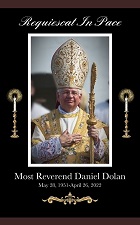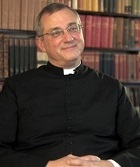The Thesis of Bishop Guerard des Lauriers (“The Thesis of Cassiciacum”) and "Lefebvrism"
Question: What is the difference between “The Thesis of Cassiciacum” and "Lefebvrism"?
Bishop Daniel Dolan, who is not the “Thesis” adherent, explains the position of Archbishop Lefebvre as follows:
“The Lefebvrist solution, simply stated, is this: to recognize the authority of John Paul II, but not to follow him in his errors…Archbishop Lefebvre replied that no authority, including that of the pope, has the right to tell us to do something wrong. But the Novus Ordo is wrong. Therefore the pope cannot oblige us to accept the Novus Ordo. This reasoning led to the need to sift the Novus Ordo for Catholicism. Like the man panning for the grains of gold hidden in the mud, so the Catholic had to sift Paul VI’s and John Paul II’s magisterium and decrees for grains of the true faith.”
(The Apostasy of John Paul II: A Catholic Response)
One of the differences between the “Thesis” and “Lefebvrism” is that “Lefebvrist” bishops and priests offer Holy Mass una cum Vatican II pope as the Head of the Church, while the "Thesis" bishops and priests assure their faithful that they offer Holy Mass non una cum Vatican II pope as Head of the Church.
Bp. Donald Sanborn explains what is wrong with the una cum Mass (see Vatican II, the Pope and SSPX):
"21. What is the una cum Mass?
The una cum Mass is one in which the name of Benedict XVI is inserted into the first prayer of the canon.
22. Who offers the una cum Mass?
Novus Ordo priests when saying the Novus Ordo or the Indult Mass, priests of the Fraternity of Saint Peter and similar organizations, and the priests of the Society of Saint Pius X.
23. What is wrong with the una cum Mass?
The una cum Mass is wrong because Benedict XVI is not a true pope. The mentioning of the pope in this part of the Mass is to profess communion with him as head of the Church.”
If these answers are to be believed, it seems that Bishop Sanborn himself and priests of his Roman Catholic Institute do not offer(?) Mass una cum papa nostro Francesco.
But let us see, is that true that the “Thesis” clergy don't offer Masses in communion with the “material pope” as Head of the Church?
Adherents of the "Thesis" say that they recognize Vatican II popes not as true Popes, but as “material popes” who don’t possess papal authority; however these “material popes” receive whatever authority they are capable of, i.e., to which they don’t posit an impediment. Although "material popes" of are public heretics, they have never been separated from the Catholic Church and, therefore, are members of the Church, and are very important persons on whom the “legitimate succession” and the “permanence of the corporeal life of the Church”, i.e., the Body of Christ, depend.
For example, according to Bishop Sanborn (ON BEING POPE MATERIALLY, SECOND PART: EXPLANATION OF THE THESIS) a heretical "material pope":
- “is able to nominate others to receive authority, (e.g., bishops) and even electors of the pope" p. 11;
- „can nominate others legally, and thus perpetually sustain the legal body of electors" pp. 12-13;
- “can, nevertheless, designate electors and even bishops for the purpose of succeeding to sees of authority, p. 13
- and even validly change the rules of election" p. 13;
- “is capable of receiving the right of designating which regards legitimate succession and the permanence of the corporeal life of the Church" pp. 13-14
From these explanations by Bishop Sanborn it is clear that he teaches that the heretical "material pope" has the power to exercise jurisdiction by designating bishops and electors of the Pope, and to make laws by changing the rules of election.
Therefore, one can conclude that the purpose of the "Thesis" was to convince its followers that the "material pope" has some essential power of the Head of the Catholic Church.
If the "Thesis" had a different purpose, then how can one explain the very rapid change of mind by the author of the “Thesis”, Bishop Guerard des Lauriers?
Fr. Guerard des Lauriers believed that the new rites of ordination and Episcopal consecration promulgated by Paul VI on June 18, 1968, were doubtfully valid or even totally invalid and, therefore, it was necessary to take action to secure a valid succession of bishops for the preservation of the Roman Catholic Church. He began discussions with Dr. Heller and Dr. Hiller, German “sedevacantist” laymen who were harboring Most. Rev. Pierre Martin Ngo Dinh Thuc. After Fr. Lauriers agreed to abate or even renounce his "Thesis" and adhere to the “Sedevacantism”, it was agreed that the Bp. Thuc would consecrate him as a bishop.
On May 7, 1981, Fr. Lauriers was consecrated bishop by Bp. Ngo Dinh Thuc. However, shortly after that Consecration, Bp. Guerard des Lauriers reiterated his "Thesis of Cassiciacum" and started a "polemical war" with the "Sedevacantists", including Bp. Ngo Dinh Thuc. This behavior of such a learned Catholic theologian seems to be rather suspicious than theologically justified. If before the Consecration he promised to accept "Sedevacantism", but shortly after the Consecration he began propaganda against "Sedevacantism" and the bishop who consecrated him, isn't that a reason for suspicion?
It seems that Fr. Lauriers had a "mission" to create an opinion among Catholics who followed Bp. Ngo Dinh Thuc, that John Paul II was a sort of legitimate pope; let these "religious fanatics" call him "material pope", the main thing is that they must think of John Paul II as if he is in possession of the very essential part of papal power or right (no matter what you call it): to appoint bishops and electors of the pope. This is exactly what Bp Lauriers achieved.
Today, more than forty years later, it has become clear that the "Thesis" was designed to help Archbishop Lefebvre to keep traditional Catholics in unity with Vatican. Although he did this job quite well, but suddenly Archbishop Thuc appeared who could destroy all the achievements of Abp Lefebvre. That is why an "assistant" of Abp Lefebvre was urgently needed, and Fr. Lauriers became that assistant. But, since he was consecrated by Archbishop Thuc, everyone must think that the "Thesis" was a kind of "Sedevacantism", not the “Lefebvrism”.
Here we return to the mentioning of the Pope in the Canon of the Mass.
If the "Thesis" adherents do not mention the name of their "material pope" in the first prayer of the Canon of the Mass, that does not mean that they are not in spiritual unity with that person, because spiritual unity is manifested not only when the priest celebrates Mass.
Since the "Thesis" adherents say that “material pope” “is able to nominate others to receive authority, e.g., bishops, and electors of the pope", „can nominate others legally, and thus perpetually sustain the legal body of electors", “can designate electors and even bishops for the purpose of succeeding to sees of authority, and even validly change the rules of election", “is capable of receiving the right of designating legitimate succession and the permanence of the corporeal life of the Church", the "Thesis" adherents actually are in the spiritual unity with "material pope" as the Head of the Church, because the above actions can only be performed by the Pope, as the Head of the Church.
Thus, answering the question that was posed at the beginning, one can say that there is practically no essential difference between “The Thesis of Cassiciacum” and "Lefebvrism". The only difference is which a sieve the propagators of the „Thesis” and „Lefebvrists” use to “sift the Novus Ordo for Catholicism”.
Fr. V
|

